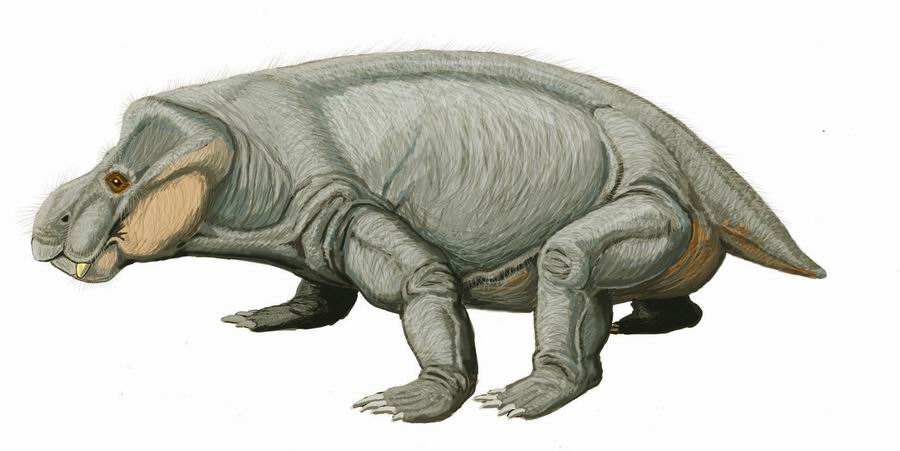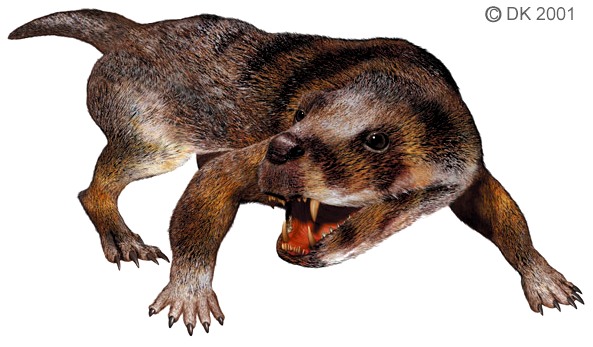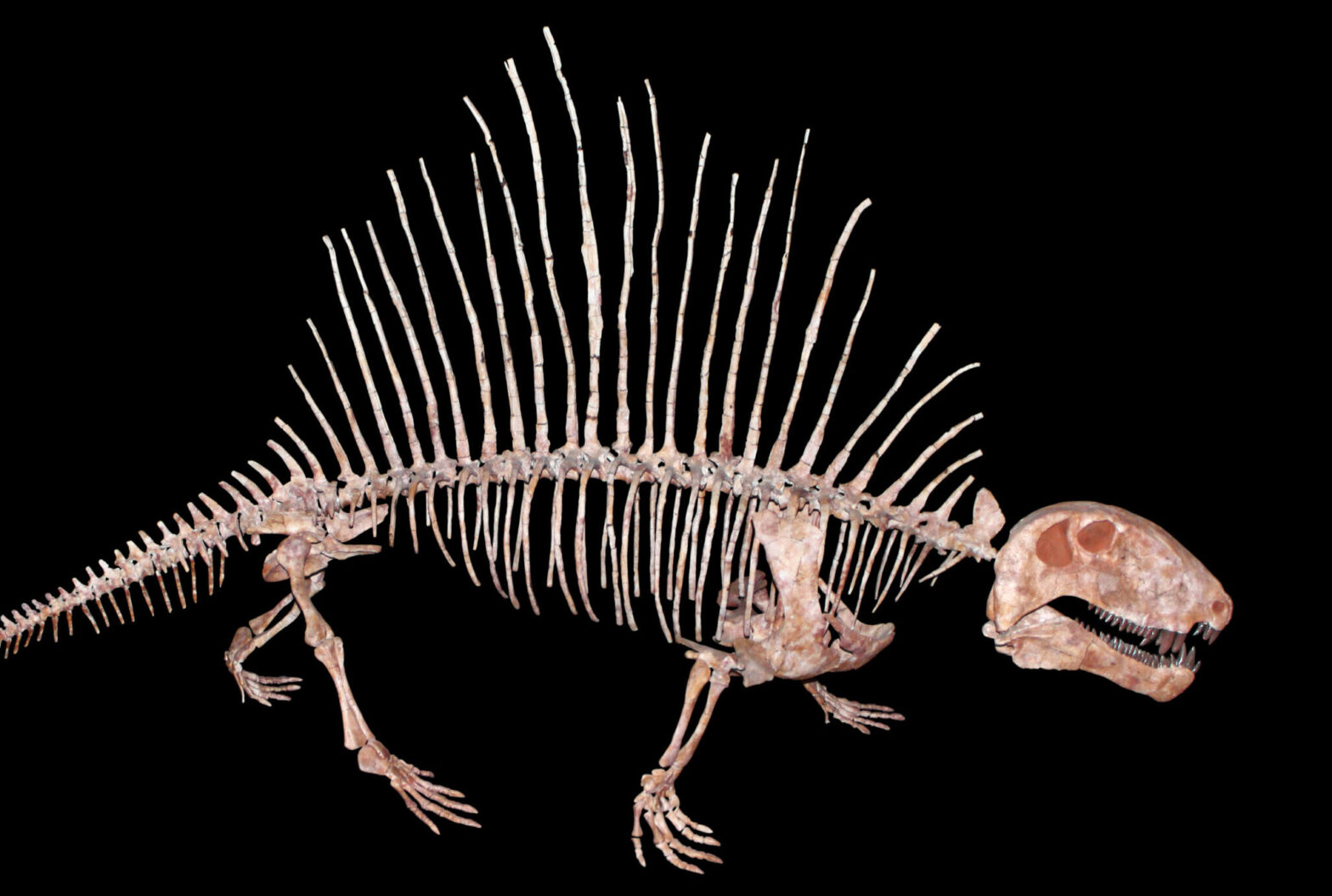Introduction
Mammals have been the dominant terrestrial megafauna on Earth since the extinction of the dinosaurs 65 million years ago. They have left an extensive fossil record, and their earliest ancestors that were distinct from other amniote lineages date back to the early Carboniferous period, 315 million years ago. But true mammals (members of Class Mammalia) wouldn’t appear until the mid-late Triassic, about 70-80 million years later! In this lab, you will explore the evolutionary history of the lineage that produced the mammals through media and 3D models of actual fossils. Then you will take virtual tours of two museums to learn more about mammal evolutionary history.
There are nine questions to answer in this module, and you can download a .docx file with just the questions here:
The early mammal relatives and all of their decendants make up a giant branch of the vertebrate tree called Synapsida. Some people call the earliest groups “mammal-like reptiles”, but this is really misleading, as reptiles are members of an entirely different branch of amniotes, Diapsida. We’ll start with the earliest synapsids, the Pelycosaurs, but first watch this short overview video on the synapsids that preceded true mammals:
Now that you have a basic idea of how true mammals evolved from these early ancestors, let’s dive a little deeper into some of the most important groups and evolutionary transitions.
Pelycosaurs
The first great radiation of Synapsids included several different groups of large lumbering “reptile-like” lineages, including the famous Dimetrodon. Have a look at the model of a Dimetrodon skull chomping down on the ancient amphibian Euryops. Feel free to use your mouse to move around the skulls and explore.
Recall that the distinguishing feature of Synapsids is the single temporal fenestra. In this model, you can see two large openings. The anterior/front hole is the eye socket. The rear hole is that single temporal fenestra. Keep an eye on that as we move forward to look at later lineages. Also note the different lengths of teeth. Yes, they all look sharp and pointed like a reptile’s teeth, but the fact that they differ slightly in size and shape means they could be used for different functions while chewing.
1. How might the longer canine-type (caniform) teeth be used differently than the smaller teeth in the rear of the jaw?
Now have a look at a 3D model of Dimetrodon with its skin on and watch this video about Dimetrodon.
Probably the most recognizable feature of Dimetrodon and many other Pelycosaurs of the time is the large “sail” formed by a row of long spines growing out of the vertebrae of the spinal column. While we still don’t know its exact function, there have been several hypotheses including thermoregulation or sexual signaling.
2. Based on what you learned in the video, explain how the current evidence suggests that its primary function was most likely as a sexual signal, and why the evidence is less supportive of the thermoregulation hypothesis.
By the end of the Permian, the pelycosaurs were gone and replaced by a more advanced group of synapsids, the therapsids.
Therapsids
Therapsids are another wastebasket group of synapsids that include big predators with long, sharp teeth, but also the very first large terrestrial herbivores! One of these groups, Dinocephalia, had bumpy heads with bony projections that they probably used as battering rams. Another group was the Dicynodonts (see Kannemeyeria below), huge herbivores with large canines, a “beak” that lacked teeth, and a bodies that weighed up to 1000kg (2200lbs)!

But there were still huge predatory hunters like the Gorgonopsians, with large canines, huge skulls with strong muscles for chewing, and bear-like bodies weighing about 300kg. Look at the skull and body of the gorgonopsian Inostrancevia.
3. Inostrancevia has the more advanced Therapsid skull and body adaptations. Looking at the skull, describe the shape and size of the temporal fenestra relative to Dimetrodon. Looking at the full body, what is happening to the position of the limbs?
Most of the therapsids died out in the Permian extinction 252 million years ago when three-quarters of terrestrial species went extinct. This led to the next major synapsid radiation, the cynodonts.
Cynodonts
The cynodonts are a wastebasket group of lineages that lived in the Triassic and were very similar to the therapsids that came before them. But they also possessed more mammal-like features than their predecessors. One of the most well-known cynodonts, Thrinaxodon liorhinus, was weasel-like in shape and one of the few carnivores of its time. Look at the skull model and the body image shown below.

4. What new advancements do you see in the skull of Thrinaxodon relative to Inostrancevia?
In addition to changes in the skull, these groups had a muscular diaphragm to assist with breathing, whiskers on the snout, a complete secondary palate that allowed them to chew and breathe at the same time, and a jawbone with only few bones left in it (recall that pelycosaurs have 7 bones in the lower jaw and true mammals only have 1, the dentary bone). The last cynodont groups were even more mammal-like in their features, and it’s difficult to know where to draw the line between them and “true mammals”, but most consider the possession of a single dentary bone in the lower jaw with the jaw articulation between the dentary and squamosal bones to be the best indicator of what defines a true mammal.
Mammaliformes
The first true mammals are described as mammaliformes because they aren’t part of crown-group Class Mammalia, which branched off a little bit later and includes all of the extant true mammals. These mammaliformes were mostly mouse-like in size and appearance. Critically, they possess the defining synapomorphy of true mammals: a single dentary bone in the jaw articulating with the squamosal bone in the cranium to form the jaw joint. One of the most primitive true mammals was Morganucodon, a shrew-like Morganucodont. Mammaliformes only had one round of tooth replacement (diphyodonty), as opposed to multiple waves of tooth replacement of their ancestors (polyphyodonty). Look at the Morganucodon skull model and body drawing below.

The Docodonts, another major mammaliform group, were unique in that they had complex, square crowns on the molars (rather than three-cusped patterns of Morganucodon and other early insectivores), suggesting they had a more omnivorous diet. Discovery of full skeletons revealed that this group varied widely in ecology and lifestyle. There were arboreal, squirrel-like species (e.g., Agilodocodon), mole-like burrowers (e.g., Docofossor), and beaver-like swimming diggers (e.g., Castorcauda lutrasimilis).
5. What advancements in the skull do you see in Morganucodon compared to Thrinaxodon and the other skulls before it? Pay special attention to the teeth, zygomatic arch (“cheekbones”), braincase, and jawbone.
Subsequent mammaliformes, members of crown-group Class Mammalia including extant Monotremes and Therians, diversified greatly from these early forms, but most were still quite small as they were living among the dinosaurs. They were probably mostly burrowing or living deep in vegetation to stay safe, and remained in hiding for about 130 million years. The dinosaurs went extinct 65 million years ago, which means that for 2/3 of the age of mammals (~200 million years), mammals were living in hiding from the dinosaurs. It has only been in the last 1/3 that mammals have emerged as the dominant terrestrial animals and have grown in size and diversified into all ecological niches.
Virtual Field Trips
Finally, while you may not be able to see these amazing fossils in person, many museums now have virtual tours that allow you to walk through and see all of their exhibits for free! The American Museum of Natural History in New York City has one of the very best public exhibits of fossil mammals in the world, and today you will get a chance to see it virtually! Begin your walkthrough with the synapsids here to get to the best starting point for the tour.
As you move through the exhibits, look at each area (look for X’s on the floor and arrows guiding you around) and try to zoom in (controls in the bottom left corner) on the displays to read what they say. Below are seven skeletons to find that are labeled clearly enough to identify and bear adaptations that deviate significantly from the earliest small mammals (e.g., Morganucodon).
- Simosthenurus – an extinct kangaroo
- Edentates: Glyptodont – the traveling tank
- Edentates: Giant ground sloth
- Carnivores: Smilodon
- Megaloceros – the giant Irish Elk
- Stenomylus – a small camel
- Mammut – mastodon
6. Find five of these skeletons, select ONE favorite and take a screenshot. Submit the screenshot to your instructor, and briefly describe TWO clear skeletal features of the skeleton you selected that differ from Morganucodon and what the function of each change might be (e.g., large antlers evolved for sexual combat).
Finally, we’re going to move forward in time to the last Ice Age (50K years ago) and take a tour of the La Brea Tar Pits in Los Angeles. Interestingly, “La Brea” means “the tar”, so you’re really visiting “The The Tar Tar Pits”! The tar pits are amazing treasure troves of fossils big and small, from microfossils of sea life and pollen to megafauna like mammoths, mastodons, dire wolves, and saber-toothed cats. Read the information in their virtual tour, look through the image slides, and watch the short videos.
7. Why did paleontologists reopen Pit 91, and what type of information have they learned?
8. How do the paleontologists use modern bones from outside the tar pit?
9. Why are there far more large carnivores in the tar pits than herbivores?
10. How and why have coyote diets changed from before the extinction of other large carnivores (e.g., sabre-toothed cats and dire wolves) to present day?
